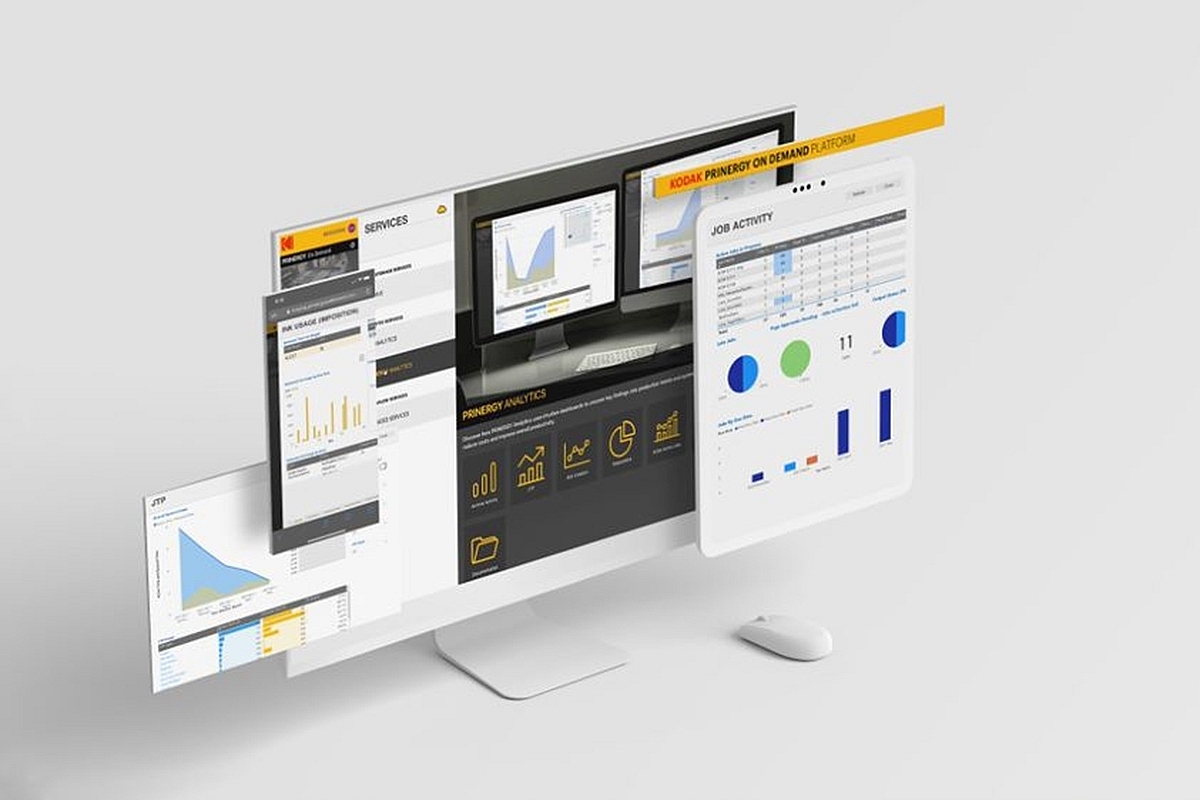Power Your Print Business with Analytics

From the moment new work enters the business to delivery and invoicing, printing businesses are a mix of orchestrated and structured activities and ad hoc business decisions. Savvy print operations leverage smart automation because every touchpoint brings potential delays and costs. Their goal is to automate specific tasks while pursuing a plan for continuous improvement that uses data and analytics to create a more effective business environment.
Most printers have analytics in place to help run the business. They ingest data and produce charts and graphs based on generic algorithms that suit how the business operates. These static algorithms build an administrative baseline, but they don’t learn as the company grows, and they don’t reach into the prepress area. Insights derived from the business data miss the input from production that might change how resources are used and where investments are made.
Using AI for more complete data
KODAK PRINERGY on Demand Business Solution expands your options by implementing comprehensive automation that uses the power of artificial intelligence (AI), including Machine Learning (ML), to collect more data and provide deeper insight. This automation does more than program repetitive tasks, it learns over time by watching for patterns and adjusting to compensate for emerging needs. By linking the business and prepress data in the same analytics platform, data is analyzed consistently, providing a more comprehensive range of input to every business decision made. Business and production insights become more relevant because the algorithms detect more precise patterns. As bottlenecks begin to appear in production, real-time analysis enables dynamic adjustments to keep work moving smoothly.
Consider Proof and Approval functions, a common bottleneck. Knowing how long the cycles are for each job, not just aggregated averages, can be revealing. Customer-specific or product-specific friction might require new rules to ensure smooth processing but writing those rules can take time. Now imagine a solution that sees the friction and adds appropriate rules based on existing workflow patterns. Optimizing these processes is how AI/ML becomes a differentiator.
Fulfilling the promise of the Internet of Things with an analytics-supported workflow
When the concept of the Internet of Things (IoT) emerged, the promise was an expanded ability to capture more data, analyze more data, and then use that data to guide operations more efficiently. That is how PRINERGY on Demand fulfills the promise of the Internet of Things. Data guides incremental adjustments to the rules that drive more efficiency from each manufacturing process. These AI-enabled applications eliminate mundane tasks by automating data analysis and using that analysis to refine processes incrementally.
Take the Proof and Approval example. When the job is ready for proof approval in a typical workflow, the system may kick off an email to the client. The schedule may call for approval within 48 hours, but if that approval doesn’t happen, the project sits idle until it does. There may be rules to send follow-up emails until there is a response, but it is rare to see the data behind those delays captured and analyzed.
In the Analytics-supported workflow, more data can be captured to provide insight into delays. Instead of identifying that a delay happened, the new process can capture more discrete data, including the average delay by customer or product type, the number of delays by customer, and even the costs for each delay. For example, reviewing and approving changes made to production files by internal and external users can be time-consuming. Mistakes made during this critical step in production can cause spoilage, rework and or downtime on press. PRINERGY On Demand Business Solutions allows you to analyze or “see in real-time” how much time and effort users are applying towards this critical task. Likewise, you can analyze production activities across your staff in real-time to identify operators or automated processes that may need refining or additional training to reduce spoilage and wasted labor hours.
Constant testing. Constant improvement. Maximum efficiency.
Automating data collection and analysis will also expose rules that are mismatched to project requirements, but that automation can do much more. It can show where pricing models are out of sync with the real production costs and which products should be retired. With constant testing of each data point, bottlenecks surface before they become costly.
The goal of modern print manufacturing is to operate by the numbers. This can be a significant change for organizations that rely on their internal subject matter experts to guide business and production decisions. The proof is in the results, however. Implementing AI-managed ML-enabled data capture and analysis puts the data hiding in your processes to work, freeing time, and resources, providing more opportunities to grow the business.
Click here to learn how Modern Litho uses their PRINERGY on Demand analytics to drive their business forward.
And see how integrating your print and business processes (PDF) can unlock new opportunities for growth